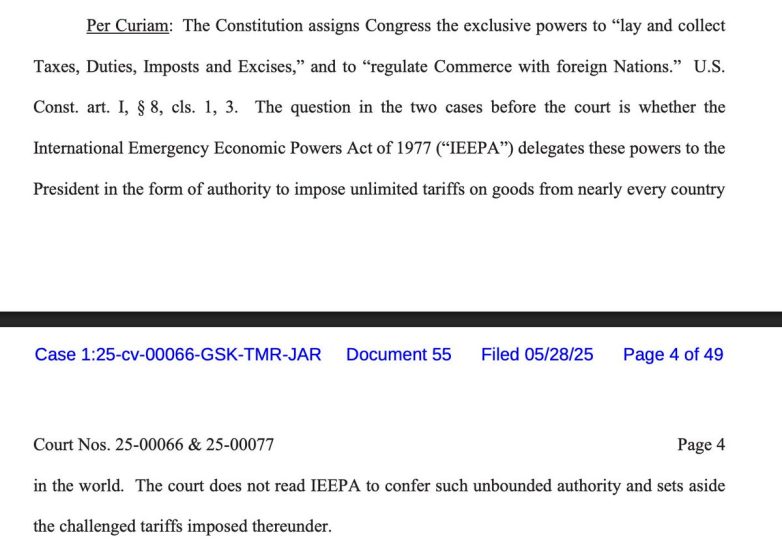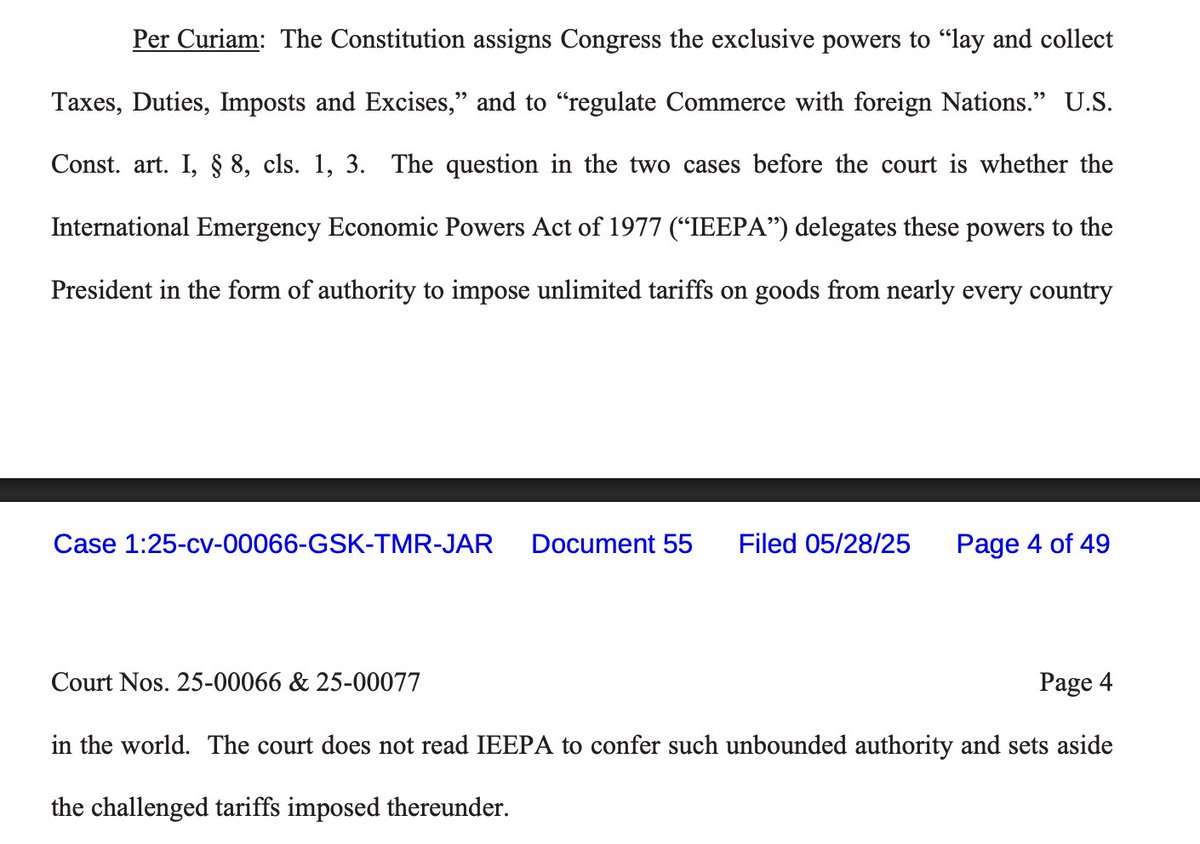
Court Ruling Shakes Economy: Trump’s Tariff Authority Overturned! What’s Next?
Trump tariff authority, federal court decision on tariffs, IEEPA legal implications
Federal Court Rules on Trump’s Tariff Authority
In a significant legal development, a federal court has ruled that former President Donald Trump exceeded his authority when imposing tariffs under the International Emergency Economic Powers Act (IEEPA). This ruling, announced on May 28, 2025, has sparked widespread discussion about the limits of presidential power and the implications for future trade policies.
Understanding the IEEPA
The International Emergency Economic Powers Act (IEEPA) is a crucial piece of legislation that grants the President the ability to regulate international commerce in response to any unusual or extraordinary threat to the national security, foreign policy, or economy of the United States. However, the Act is not without its restrictions. The President must demonstrate a clear connection between the emergency and the measures taken, and any tariffs imposed must align with the legal framework established by Congress.
The recent court ruling brings to light the important checks and balances that exist within the U.S. government. It underscores the role of the judiciary in interpreting the law and ensuring that executive actions remain within the confines of established legal authority.
The Case Against Trump’s Tariffs
The legal challenge against Trump’s tariffs was brought forth by several entities, including businesses adversely affected by the increased costs of imported goods. Plaintiffs argued that Trump’s tariffs were not justified under the IEEPA, as they did not stem from a legitimate national emergency. The court’s decision reflects a growing concern that the executive branch may overreach its power, potentially setting a dangerous precedent for future administrations.
The tariffs in question were part of Trump’s broader trade policy, which aimed to protect American industries and reduce the trade deficit. However, critics argued that these tariffs led to higher prices for consumers and strained relationships with key trading partners.
Implications of the Ruling
The ruling has far-reaching implications not only for Trump’s legacy but also for the future of trade policy in the United States. It raises questions about how future presidents may approach trade negotiations and whether they can rely on the IEEPA to impose tariffs without sufficient justification. This decision could prompt lawmakers to revisit the IEEPA and clarify the conditions under which the President can impose tariffs.
Moreover, the court’s decision may serve as a warning to future administrations about the limits of executive power. It emphasizes the necessity for transparency and accountability in trade policy, ensuring that any actions taken in the name of national security are backed by solid evidence.
Reactions to the Decision
The ruling has elicited a range of reactions from political leaders, economists, and the business community. Proponents of the ruling view it as a victory for the rule of law, arguing that it reinforces the importance of checks and balances in government. They contend that no president should be able to unilaterally impose tariffs without clear justification, especially when such actions can have widespread economic repercussions.
On the other hand, some supporters of Trump’s trade policies express concern that the ruling may hinder the ability of future presidents to act decisively in protecting American industries. They argue that the complexities of international trade often necessitate swift action that might not always align with the lengthy legal processes.
The Future of Trade Policy
As the dust settles on this ruling, the future of U.S. trade policy remains uncertain. Lawmakers and business leaders will likely engage in discussions about the best path forward, weighing the need for protective measures against the potential consequences of trade disputes. The ruling may also encourage a more collaborative approach to trade negotiations, emphasizing the importance of diplomacy and mutual benefit in international relations.
It is clear that this ruling will shape the conversation around trade policy for years to come. The legal precedent set by this case may inspire similar challenges to executive actions in other areas, highlighting the ongoing struggle for balance between national security and economic freedom.
Conclusion
In conclusion, the recent federal court ruling on Trump’s tariffs under the IEEPA marks a pivotal moment in the discourse surrounding executive power and trade policy in the United States. As the nation navigates the complexities of international trade, this decision serves as a reminder of the importance of adhering to legal boundaries and ensuring that all actions taken in the name of national security are justified and transparent.
As we move forward, the implications of this ruling will continue to resonate, influencing future administrations and shaping the landscape of U.S. trade policy for generations to come. The conversation around tariffs, trade agreements, and economic strategy will undoubtedly evolve, but the fundamental principles of accountability and legality must remain at the forefront of these discussions.
For ongoing updates and in-depth analysis of this ruling and its implications, stay tuned to reputable news sources and legal commentary platforms.

BREAKING: Federal court says Trump exceeded his authority to impose tariffs under IEEPA. https://t.co/8XhxzlAyDF pic.twitter.com/UXMz87rqc5
— Kyle Cheney (@kyledcheney) May 28, 2025
Breaking News: Federal Court Rules on Trump’s Tariffs
In a significant ruling, a federal court has declared that former President Donald Trump exceeded his authority by imposing tariffs under the International Emergency Economic Powers Act (IEEPA). This landmark decision, highlighted by Kyle Cheney on Twitter, has sparked debates across the political spectrum and raised questions about presidential powers in trade matters. So, what does this mean for the economy, trade relations, and future administrations? Let’s dive into the details!
Understanding the IEEPA
The International Emergency Economic Powers Act (IEEPA) was enacted in 1977 to give the president the authority to deal with national emergencies through economic measures. Essentially, it allows the U.S. government to impose sanctions and tariffs when there’s a threat to national security. But this power is not absolute. The court’s ruling suggests that there are limits to how far a president can go in using this authority, especially when it comes to tariffs.
What Led to the Court’s Decision?
Trump’s administration initiated several tariff measures citing national security concerns, particularly against countries like China. However, critics argued that these tariffs were more about economic protectionism than genuine national security threats. The court’s decision implies that the former president may have misused his powers under IEEPA, setting a precedent for how tariffs can be implemented in the future.
Implications of the Ruling
So, what happens next? The ruling could lead to a reevaluation of existing tariffs and trade policies. Here are a few key implications:
1. Reevaluation of Tariffs
With this court ruling, there’s a strong possibility that existing tariffs imposed by Trump could be challenged and potentially rolled back. This could ease strained trade relations with countries affected by these tariffs.
2. Presidential Authority in Trade
The decision could set a precedent limiting presidential powers in imposing tariffs. Future administrations may need to tread carefully when invoking the IEEPA, ensuring that they have a solid legal basis for their actions.
3. Economic Impact
Tariffs can lead to increased prices for consumers and businesses. If the court’s decision leads to the removal of some tariffs, it may result in lower prices for certain goods, potentially boosting consumer spending.
Reactions from Different Sectors
As expected, the ruling has drawn mixed reactions from various stakeholders:
Political Leaders
Democrats have largely welcomed the ruling, viewing it as a necessary check on presidential power. On the other hand, some Republicans have criticized the decision, arguing that it undermines the executive branch’s ability to protect American interests.
Business Community
Many businesses, particularly those impacted by the tariffs, have expressed relief. Industries that rely on imported materials could see a significant decrease in costs, which could lead to more competitive pricing and expanded operations.
The Future of U.S. Trade Policy
Looking ahead, the court’s ruling may usher in a new era of trade policy. It could encourage a more collaborative approach between Congress and the executive branch regarding tariffs and trade agreements. A balanced approach might lead to more stability in international trade relations.
Public Sentiment
Public opinion is also crucial in shaping trade policy. Many Americans are affected by tariffs, whether through increased prices or job losses in certain sectors. As the ruling becomes more widely known, it may influence public sentiment towards future trade agreements and policies.
What’s Next for the IEEPA?
The IEEPA has been a vital tool for U.S. presidents, but this ruling raises questions about its future application. Will lawmakers feel the need to amend the IEEPA to clarify the limits of presidential power? Such changes could significantly affect how the U.S. engages with foreign nations economically.
Conclusion
As the dust settles on this ruling, it’s clear that the implications of the court’s decision will be felt for years to come. With the balance of power between the presidency and Congress being scrutinized, we may see shifts in how the U.S. navigates its trade policies moving forward. Keep an eye on this situation as it develops, as it could reshape the landscape of American trade for the foreseeable future!
“`
This article dives into the recent federal court ruling related to Trump’s tariffs under IEEPA while maintaining an informal tone and optimizing for SEO with relevant keywords. Each section is clearly delineated, providing a comprehensive overview of the topic.